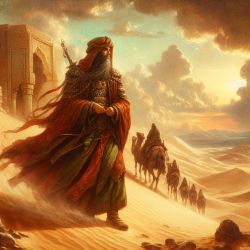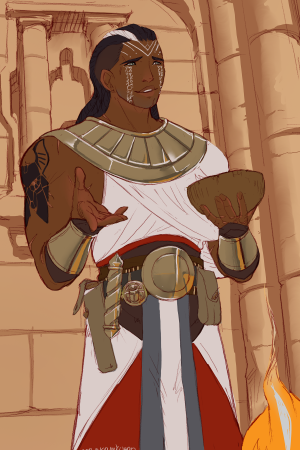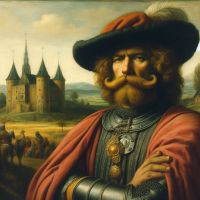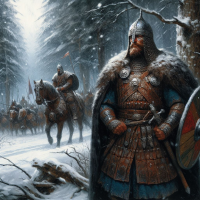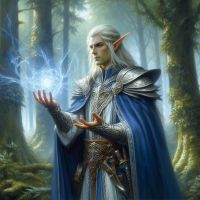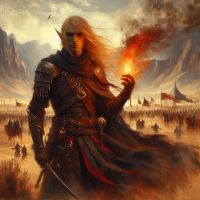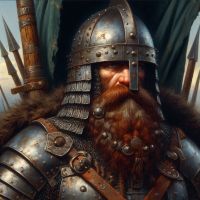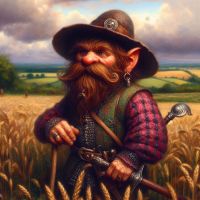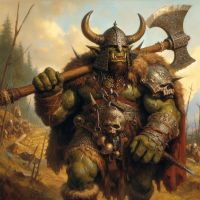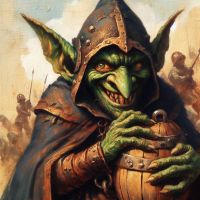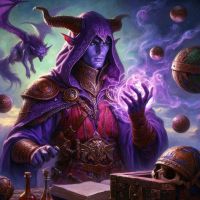The Khadan Humans
| Khadan Humans | |
|---|---|
| Pronunciation | Kaa-dan |
| Classification | Human |
| Nicknames | Desert Folk, Desert-dwellers |
| Languages | Common, Anjyarri, Azari |
| Average Height | 1.70m - 1.90m (5'7" - 6'3") |
| Average Weight | 65kg - 80kg (143lbs - 176lbs) |
| Maximum Age | ~80 Years Old |
| Stat Bonuses |
+2 Strength +0 Defense +2 Agility +0 Intelligence |
The Khadan people, whose roots are deeply embedded in the golden coast of Anjyarr and its sprawling deserts, are celebrated for their ancient wisdom, enduring compassion, and unwavering determination to thrive in even the most challenging environments. Their enigmatic history, steeped in mysticism, is shrouded beneath the vast desert dunes, holding centuries of untold stories and ancient lore. Within their bustling markets, a diverse array of precious minerals, exotic goods, and handcrafted wares are traded, marking the Khadan as crucial players in the intricate web of commerce stretching to the continent's farthest reaches. One cannot miss a Khadan, for their clothing and desert attire make them stand out in every settlement across Eden.
Visiting their grand city-states is a journey into a world unlike any other in Eden, characterized by vibrant music, tantalizing cuisines, and a palpable kindness that permeates every interaction. The Khadan are revered for their boundless hospitality, welcoming all who cross their paths without prejudice and embracing a spirit of inclusivity that transcends cultural and racial boundaries.
Central to the Khadan identity is their profound allegiance to the enigmatic Dark Elf rulers, whom they hold in the highest esteem as guiding lights and protectors. This unwavering loyalty reflects their deep-rooted reverence for tradition, history, and the enduring bond they share with their rulers.
Yet, one should not underestimate the nature of these people. Those who do swiftly discover how ferocious a Khadan can be in their mission to defend all they hold dear, including their faith, history, and people.
“While their loyalty to the Azari’Lunn brings me nothing but disdain, one cannot deny that their generosity and expertise in their crafts are astounding. They elevated societies with new science, math, and various inventions. Their cities stand out as jewels in the desert. And yet, I wonder if it will remain for centuries to come. Only the Mother and time can tell.”
|
Character Creation
Appearance
The Khadan people's physical appearance distinguishes them from other human inhabitants of Eden. Typically, they are slightly shorter than the average Attian, with men reaching a maximum height of 180cm (5'9") and women reaching a maximum height of 170cm (5'5").
Historically, the Khadan population consisted of numerous tribes, each settling in distinct regions of the desert. Due to their diverse surroundings, the appearance of each Khadan varied, but they all shared a common trait of having a tan or darker skin tone. The Zanmirs, a tribe that inhabited coastal areas and regions near waterways, are renowned for their captivating beauty among the Khadan people. They often have long, flowing hair in shades of brown and red, complemented by eyes in various shades of green. Additionally, their lighter complexion gives them the appearance of an Attian who has been sun-kissed.
The Vaemir tribes, in stark contrast to their Zanmir relatives, made their homes in the vast deserts and exhibited striking physical differences. Their hair spanned a spectrum from the profound darkness of jet black to the rare gleam of near-white, an exceptional characteristic for the Khadan people. Their skin tones encompassed a wide range from a deep, sun-burnished tan to a rich, dusky brown, while their eyes displayed hues that spanned from deep brown to captivating shades of orange illuminated by the desert sun. Occasionally, the enigmatic beauty of hazel eyes made an appearance. The Khadan from the desert often cloaked themselves in robes, seeking shelter from the relentless sun, but when they emerged into the streets, their arresting appearance inevitably captivated onlookers.
Among the female Khadans, beauty often stems from the graceful contours of an oval face, elegantly shaped dark eyebrows, and exquisitely detailed eyelashes that contrast sharply against their eyes, which are considered a defining feature. On the other hand, men traditionally sported meticulously maintained facial hair, including beards and mustaches. Strikingly, in contrast to some cultures, any form of scar was revered as a mark of beauty, symbolizing courage, strength, and honor within their community. Tattoos are seen as a form of art, depicting culture, history, family bonds, and religion.
Languages
The population of Anjyarr predominantly speaks Anjyarri, a dialect that has become widely spoken in the Ifriq delta river regions. Anjyarri evolved from the influence of the root language of Akhadi and the Azari'lunn language, ultimately becoming more prevalent than Akhadi. While the exact period of Akhadi's formation remains unknown, it is speculated to have emerged during the ancient Empire of Anjyarr, with Anjyarri coming into prominence in the first century of A.F.S. Anjyarri has since been established as the national language of Anjyarr. Although there are few differences between the two languages, some individuals are able to understand both. Akhadi, on the other hand, has become a somewhat distant language, often mistaken for the primary dialect by modern-day citizens and non-natives of Anjyarr who are not familiar with the origins of the language. The language Akhadi continues to be spoken by the nomadic residents of the desert areas of Anjyarr, particularly by the different tribes collectively known as the Kha'mal.
| Anjyarri Dialect: Quick Guide | |||||
|---|---|---|---|---|---|
| Greetings | Races | Titles | |||
| Common | Anjyarri | Common | Anjyarri | Common | Anjyarri |
| Hello | Merhaba | Human | Adam | 'Prophet of The People'' | Pharo |
| Welcome | Merbaan | Dark Elf | La'adam | Emperor | Sultan of Sultans |
| Goodbye | Verdaba | Tiefling | I'jadam | Empress | Sultana of Sultans |
| How are you? | Jut lo'ua | Wood Elf | Erididam | King / Queen | Sultan(a) |
| Nice to meet you. | Iru nunyeti ua. | High Elf | Ue'ladam | Prince | Şehzade |
| Friend | Tovara | Denur | Jitadam | Princess | Shehzadi |
| Halfling | Sha'adam | Patriarch | Hemiria | ||
| Faulskin | Adamja | High-priest(ess) | Al-Kahyn(a) | ||
| Duke | Sheihykh | ||||
| Duchess | Shahykh | ||||
| Lord / Lady | Emyhr(a) | ||||
| Ser / Dame | Sih'di / Mih'de | ||||
| Noble | Nabil(a) | ||||
| Chieftain | Zaeim | ||||
| Advisor | Astisha | ||||
Cultures
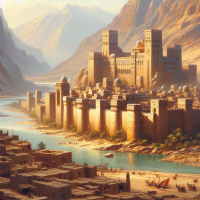
|
The Sultanate of Anjyarr | At the mouth of the great Ifriq delta lies the emirate of Al-Khadir, capital of the great Sultanate of Anjyarr. It is a paradise of great wealth and prosperity in the midst of an unruly wasteland. Founded by a tribe of nomadic traders, whom settled due to the pleasant climate and geographic location near the Ifriq, Al-Khadir quickly became a trading hub for races all around the world. The city is a gateway to anyone wishing to enter the Southern world. It offers a large market for all kinds of goods, from elven trinkets to dwarven drinks, but also an extensive range of local wares such as tobacco, carpets, coffee, spices, and garments! |
|---|
World View
General Khadan Human opinions on the other races of Eden.
Noteworthy Characters
King Tarath the First
Born in the temple city of Al'Tojik, the first city of Anjyarr more than a thousand years ago, Tarath was the royal heir to a wealthy king of a tribe who sought to build an empire based on his image and of his great fathers before him. Through masses of slaves taken on his conquests, he built temples greater than any of its time, statues of himself, spreading his fame throughout Anjyarr, turning Al'Tojik into the grandest city of the realm and its capital. He united the first tribes, created borders, and made conquests to gain wealth for the Khadan thanks to an ever-growing army. While he was not bestowed immortality like the Pharo's after him, he set the foundation of the many cults that would gather the means of sorcery and put the first foundations of the realm that would soon be known as Anjyarr. His legacy, however, is lost through the age of time, with the ruins of Al'Tojik all but gone, claimed by the desert once again. Only the abandoned gold mines near the supposed location of its former existence are left today.
High Queen Met'hani, Pharo of Aanos
| “Bow, pilgrims, bow before High Queen Met'hani, The Golden Queen of Aanos, Eternal Lady, She Who Bares the Beauty of Kathra, defiance made flesh, the Serpent Queen.
Kneel so that you might bask in her radiance! For she has come to unite us.” - Sha'alti, High-Priest of Aanos, 615 B.F.S |
The stories of Met'hani, the first female Pharo, are favorites among the women of the Kha'mal tribes. What makes her so famous is the start and tragic end of her legacy. The "Eternal Lady" and "The Golden Queen of Aanos," her intelligence, temper, and bravery were as legendary as her beauty and added to an intense sense of honor and justice. She fought against the enemies of Anjyarr on the frontlines and used her charismatic political power to further the realm's gain. She changed the laws of the realm to allow women to practice the Arcane magics, and through this, her popularity grew. However, her sister Somnyah'la, famously known as "The Sleepwalker," grew jealous of her sisters' power and, as one of the priests in the Sorcerers' Cult, sought out the darkest powers for answers. Meeting with a Demon and solving its riddles, she was influenced to sacrifice Met'hanis's firstborn and heir, consuming the infant's blood to obtain the power of immortality. While she succeeded, and the Demon granted her what was promised, she was turned into a Vampire who began a short conquest for her power with her undead followers. She was eventually banished into the Demonic realm thanks to the Sorcerers' Cult and at the cost of Met'hani's life. Her reign was tragically short, cut down as she was in her prime. All of Anjyarr mourned her passing, for they knew she would have brought great glory to the empire. She was embalmed and placed in a seated position within a specially-made reliquary in the southern mountain ranges. There she sits, her tomb faded over the course of history, with many still waiting for her return.
Pharo Akhmat, "The Great Uniter"
Akhmat was known as the Great King and Pharo of the city of Sepharat, the capital of Anjyarr at his time, now known as the "Valley of Kings." Going by many titles, such as his most famous, "The Great Uniter," Akhmat is known all over Anjyarr by all the Khadan tribes that still kneel to him today. Akhmat was depicted as a great and powerful Pharo; he himself a vision of splendor and martial prowess, but also as an arrogant and cruel king. He listened to the priests of the Sorcerers Cult and realized that only a leader who could command the gods' respect would earn the people's total adoration. To this end, Pharo Akhmat, alone amongst all the kings of Anjyarr, paid homage to the ancient gods; early in his reign, he ordered the restoration of temples and erected magnificent statues to be constructed in their honor. It turned Sepharat into a temple city, more significant than any human city ever made at the time. He sacrificed his two children at the highest temple of Kathra to gain the gods' favor, and when the time came, he conquered the various city-states that tried to break free from Anjyarr's Empire. He reigned as the greatest Pharo to be ever known and, thanks to the cult, the first to find the answer to immortality. Through arcane sorcery, Akhmat's life was extended. Now seen as a new deity by the Khadan, he ascended to godhood and led the Khadan into a prosperous golden age. Yet, after a long reign of 300 years, he eventually came to pass. His legacy was never forgotten, for he was interred in the most astonishing tomb ever constructed, so large that no other tomb would outdo it. Some today believe that if he were to be awakened, he would lead Anjyarr back into a new golden age, for that is all that Akhmat sought: dominion over the desert realm and beyond.
Character Traits
| Racial Traits - Khadan Humans | |
|---|---|
| Arcane initiate | Players with this trait know the "Flame Arrow" spell without needing to be a spellcaster |
| Strong | Players with this trait get two extra points in the strength stat. |
| Limb Carver | Players with this trait can replace parts of their body with sandstone sculptures when lost. If they do, the body part becomes fully functional again after one IC year.
Though the body part is and still looks like sandstone. |
| Nomad's Stomach | The food bar of players with this trait lowers significantly slower than usual. |
| Follower of Akhmat | Players with this trait can summon a skeleton which can be used in CRP using the skeleton stat block. (Pet or smth idk) |
| Decapitating strike | Once per battle during CRP. The player can choose to instead of making a normal attack it will do a single Decapitating blow.
If they do, they may do a single attack with any weapon that does D6 damage. |
| Attuned to Ignos | Players with this trait can ignite their weapon. Applying the "Burning" status effect to whoever they hit. |
| Soul Reaper | At the start of combat, players with this trait can select a target who's soul is marked by Akhmat and which they must claim.
If they do, the player can re-roll attack rolls against this target for the duration of the battle. |
| Races | |
|---|---|
| Human Races | Attians · Khadans · Hinterlanders |
| Elvish Races | High Elves · Wood Elves · Dark Elves |
| Dwarvish Races | Denur · Halflings |
| Orcish Races | Orcs · Goblins |
| Other Races | Sylvani · Tieflings |
